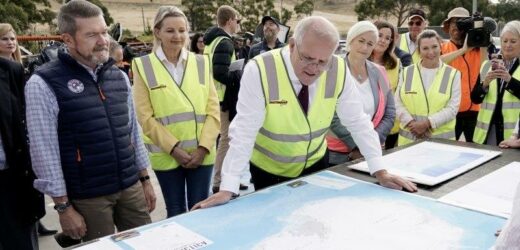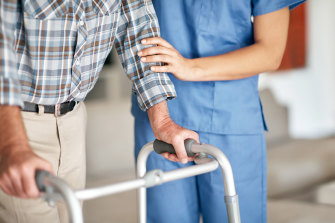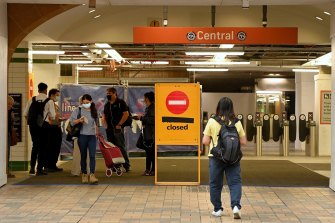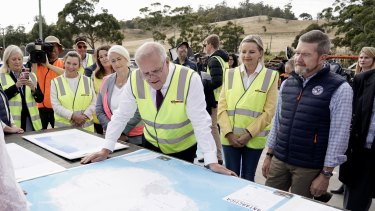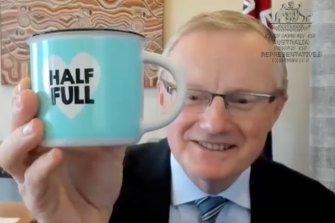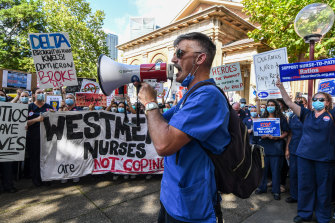On any given day Julie Kupke is a cook, cleaner, chauffeur and nurse to some of Australia’s most vulnerable people.
Frail, elderly and beset with degenerative diseases that make even eating a hazard, the clients of this aged care worker are unable to navigate the everyday without assistance.
Aged care workers are seeking a substantial pay rise after years of sacrifice. Their fight is part of a broader battle playing out in industrial relations and the economy.
Each of them is a stop in Kupke’s day as she shuttles around Melbourne to situations that can turn into medical emergencies, bathroom problems or intimate tasks such as showering and dressing that preserve the dignity of those who need home care.
An aged care worker in both homes and facilities for the past 15 years, she is subjected to 10-plus- hour days, often only adequately resourced through her own personal expenses.
“I might be in the garden digging holes, cleaning up faeces in the bathroom or cooking up a storm in the kitchen,” Kupke wrote in a submission to Australia’s workplace umpire. “Sometimes I get home from work and I am mentally very drained.”
The Health Services Union hopes Kupke’s experiences will bolster the case for a 25 per cent wage boost for the embattled sector, whose staffing vulnerabilities have been compounded by the coronavirus pandemic.
Wages for aged care workers – an issue raised in the sector’s damning royal commission – is just one of a number of growing industrial relations flashpoints across the country that could feature in the coming federal election.
For a federal government behind in every major opinion poll, a strike or a union dispute or a substantial wage claim is likely to be a staging point for a broader attack on Labor.
Just hours after Sydney’s rail network ground to a halt this week, Prime Minister Scott Morrison was on Sydney radio, rounding on the Rail, Tram and Bus Union before linking it to a union protest against the AUKUS agreement and then the federal Labor Party.
“This thing was sprung up at 2am in the morning. This is, this is just not how you behave and this is not how you treat your fellow citizens,” he said.
Even as he was speaking, it was clear unions had not stopped Sydney’s trains; it was a decision of the state government to lock out its workers.
The shutdown of Sydney’s train system was used by Scott Morrison to attack Labor and the union movement.Credit:Kate Geraghty
That didn’t stop the Prime Minister, who later on the same day clarified his attack line on Labor leader Anthony Albanese.
“If people want to hand the country over to unions, under a Labor government led by the most left-wing Labor leader in 50 years since Gough Whitlam, and that’s probably being a bit unkind to Gough, you might have to go back further than that, then this is what they can expect,” he declared.
In the cut-and-thrust of a faux federal election campaign, facts such as who left Sydney’s trains at the station come a poor second to a political fight that mixes industrial relations with the hip pocket pain being felt by most Australians.
Data released this week by the Australian Bureau of Statistics highlighted why unions are getting more agitated about wage levels and why the federal government is increasingly strident in its commentary about Labor and unions.
The wage price index for the December quarter showed a 0.7 per cent increase through the final three months of last year. It took the annual rate to 2.3 per cent – where it was before the COVID recession.
Inflation for the same quarter was 1.3 per cent, taking the annual rate to 3.5 per cent.
In other words, a fall in real wages of 1.2 per cent. As the ACTU noted, it was the equivalent of an $832 pay cut for someone on the average income of $68,000 a year.
Cost of living features at almost every federal election. Both sides of politics always claim they can ease pressures or lift wages for voters, even if the facts of the matter clash with the rhetoric.
But this year’s campaign will feature a first: wages have been outpaced by inflation since the 2019 poll. No federal parliamentary term this century has coincided with a fall in real wages.
Scott Morrison campaigning in Tasmania this week. He attacked unions over the shutdown of Sydney’s network even as it was clear the state government had shut out its workforce.Credit:Adam Taylor
It’s obviously in the mind of the federal government; Scott Morrison has mentioned an 8 per cent fall in electricity prices over the past three years at a dozen press conferences or interviews through the first three weeks of February alone.
When the wage data was released, Treasurer Josh Frydenberg took to Twitter to argue that “wages continue to strengthen” while noting that under Labor “real wages were falling”.
Real wages did fall by 0.6 per cent in the final three months of the Gillard and Rudd governments of 2013. But through their three-year term real wages grew by 2.9 per cent, not fall by 0.8 per cent as they have in the three years of Scott Morrison’s first full term.
That fall is across all wages. A key industrial battle is now brewing over the annual minimum wage case, which won’t be decided until after the May federal election.
The minimum wage has kept ahead of inflation since July 1, 2015, when it was $17.29 an hour or $656.90 a week. It now sits at $772.60 a week, or $20.33 an hour.
But since 2019, the minimum wage – like most other wages – has fallen behind inflation.
The Fair Work Commission is always a battle between business and unions, which always ask for vastly different outcomes.
Since 2015, for instance, the Australian Chamber of Commerce and Industry (one of the nation’s most important business voices) has never sought a pay increase of more than 2 per cent. The ACTU’s lowest claim over the same period has been for a 3.5 per cent lift.
A person earning $1500 a week back in 2015, if the chamber’s submissions had been accepted, would now be earning about $1617 a week. If the ACTU’s proposals had been accepted, they would be earning $1995 a week.
The commission has effectively split the difference.
Aside from the political argument, wages growth is a key economic issue. The lack of wages growth was one of the reasons the Reserve Bank started cutting official interest rates just weeks after the 2019 federal election.
Bank governor Philip Lowe has referenced a range of factors for the pressure on wages in a number of speeches over recent years.
These include the diminution of the power of trade unions, the large supply of workers coming into the labour market (which means businesses haven’t had to offer higher wages to attract new staff), cost-conscious businesses facing extreme competitive pressures and the slowdown in productivity across the country.
Reserve Bank governor Philip Lowe has argued there are a string of factors that have kept wages growth low.
He’s even urged workers to go in to their bosses and demand a pay rise.
More contentiously, the governor last year argued that the nation’s high levels of immigration were partly to blame, particularly around low-income jobs. This had enabled businesses to avoid properly training staff.
Another issue is the change in the use of technology. Firms at the IT cutting edge have been able to lift wages but those further down the technological food chain have struggled, and those struggles have translated into stagnant wage growth for their staff.
Even when a business decides it has to offer better pay, the RBA has noted the growing use of one-off bonuses or non-wage remuneration (like work-from-home concessions). A bonus might deliver a person a short-term boost to the pay packet, but by its very nature it is not something that can be depended upon.
While the Reserve Bank’s job is to focus on economic outcomes, Lowe harbours concerns about what low wages means for the broader community. In a speech in mid-2018 to Melbourne business leaders, he warned that without strong wages growth the community’s fabric could tear, while political leaders would become less willing to engage in policy change.
“The slow wages growth is diminishing our sense of shared prosperity. If this remains the case, it can make needed economic reforms more difficult,” he said.
Labour market expert Professor John Buchanan, of the University of Sydney Business School, says the slowdown in wages had both worsened living standards and retarded demand.
“On the demand side, there’s been basically an era of chronic underemployment … the underemployment rate has been ratcheting up over the past 30 years,” Buchanan says.
He added there had been a concerted push to weaken unions.
“What Australia’s got now is a problem of militant employers … just look at how the NSW government has been treating the nurses, the teachers and the train drivers,” he says.
The election campaign, however, is unlikely to be dominated by accusations of “militant employers”, as Morrison’s attack on NSW’s transport unions suggest. It’s an issue of which the Labor Party is acutely aware.
It is picking its battles carefully. But the union movement may not.
A senior union figure who declined to be named said it was inevitable there would be further industrial action in the lead-up to the election, given many unions had held over wage claims during COVID to balance the interests of the industries.
Nurses rally in Macquarie Street, Sydney demanding better pay.Credit:Peter Ray
“Now it’s clear that there were a lot of big winners who aren’t sharing those benefits,” they said.
Another senior figure, who also spoke on the condition of anonymity, said it would be a tactical decision that depended on public sentiment.
“If you’re the [Maritime Union of Australia], let’s face it, you probably won’t … or the construction unions. It just depends on who you are, and it depends on what powers who have,” they said.
Industrial disruption across Australia remains at historically low levels. Long-term figures collated by the Australian Bureau of Statistics show that in the September quarter last year there were 13,300 people involved in industrial disputes.
The last time more than 100,000 people were involved was in mid-2006. The record is almost 700,000 in the December quarter of 1992 (which failed to harm Paul Keating’s election victory three months later).
The industrial relations landscape, and its intersection with wages growth, could be at a turning point.
The stories of people like Julie Kupke, and how the COVID recession has highlighted the economy’s dependence on “ordinary” jobs such as cleaners and checkout staff, means voters are much more attuned to the importance of this vast workforce.
Labor senator Tony Sheldon, former secretary of the Transport Workers’ Union, who is chairing a Senate inquiry into job security, said there were “handcuffs on the system” in addressing wage rises.
He notes the aged care wage case could force a rethink of our wage-setting processes.
“It goes to the heart of undervalued, ‘feminised’ industries … it also goes to a really critical question, and that’s ‘will the government fund it?’,” he says.
Most Viewed in Politics
From our partners
Source: Read Full Article
